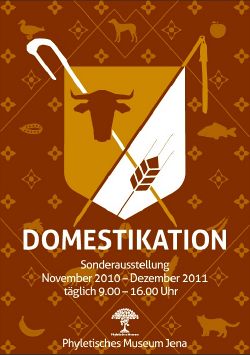DOMESTIKATION
Special exhibition
Phyletisches Museum Jena
26. November 2010 – 30. May 2011
Imprint
Idea: Prof. Martin S. Fischer
Curator: Dr. Gunnar Brehm
Concept: Prof. Dr. Martin Fischer, Dr. Gunnar Brehm, PD Dr. Hans Pohl, Elisabeth Kaufmann, Felix Sattler
Showcase curators: Dr. Gunnar Brehm, Susan Schweiger, Sandra Triepel, Stefan Curth, Pieter Knauthe, Marcus Hergeth, Karsten Swinnes
Scenography: Elisabeth Kaufmann, Felix Sattler
Graphic design: Dr. Gunnar Brehm, Konrad Angermüller
Preparators: Matthias Krüger, Michael Nickel
Designers’ keynote to the exhibition
Village Square
Much of the team's research into the history of domestication relied on Jared Diamond's book Guns, Germs, and Steel that showed how plant and animal domestication were crucial to the establishment of sedentary lifestyles. Hence, we got the idea to create the impression of a central "village square" as the key scenographic element of the exhibition.
We decided to achieve this by putting a custom-manufactured bench around the central column as a powerful visual identifier of the village square. Moreover the bench allowed for removing the usual seating from the exhibition space, hence clearing up space while giving visitors a possibility to relax and view the exhibition while becoming a part in its scenography.
Two more objects involved in typical annual (village) celebrations in traditional agricultural societies were also added to the display: a crown for decorating cows (Kuhkranz) and a "harvest crown" (Erntekrone).
To further develop the village concept and to enhance awareness of the importance of domestication for the history of civilization, we designed the logo as a village's coat of arms displaying both an animal and plant species. In addition to the cow head and wheat head, two tools were included into the logo. The crook (sheperd's staff) and flail, have been ancient insignia of both political and clerical power dating back to the age of Egyptian pharaos. Since we were able to actually lend the two tools for the exhibition, we very much liked the idea to use their accurate representation for the graphic logo. In the exhibition the logo was composited from a background print on heavy jute with the tools mounted across. Hence, visitors would be able to find "the real thing" in the exhibition they previously had already seen printed or online.
Moreover, the Bible's First Book of Moses (Genesis), Chapter 4 introduces the brothers Cain and Abel as the first farmers, hence the biblical beginning of civilization is linked with plant and animal domestication: And Abel was a keeper of sheep, but Cain was a tiller of the ground.
We found it made sense to show our coat of arms together with the Book of Moses quote to demonstrate the effect and importance of domestication not only for plant and animal evolution and diversity but also for cultural history and the evolution of political, social and religious systems.
PS: It also seemed a good joke to have a Bible quote in the "Medusensaal", right in the old sanctum of the evolution biologist and declared "Anti-Pope" Ernst Haeckel.
Kalkül und Leidenschaft (Reason and Emotion) installations
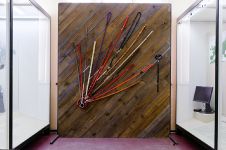
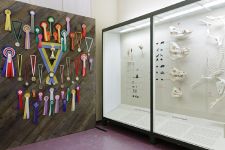
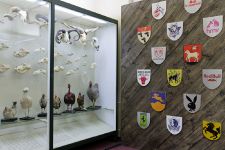
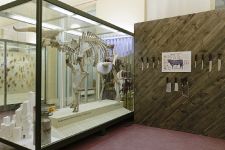
In order to balance the scientific presentation of information and artifacts in the showcases, we felt the need to devise and design a number of scenic installations that allowed for a more emotional access to the topic and that were also a possibility to use artistic means to investigate the cultural implications and "epiphenomena" of domestication. Even if we wanted them to appear very different from the showcase displays, we still wanted to use an aesthetic derived from those of natural history collections with their regard for morphological comparison and emphasis on (natural) diversity. The four installations were created as rather rough appearing wooden walls emphasizing the idea of a village square with adjacent cottage or barnyard buildings. The four topics were
Dressage (Dressur)
Dressage features a collection of dog leashes.
We tend to regard those first as a practical tool to carry out human power over animals. To us, it was even more important that they publicly visualize a distinct "channel" between human and animal. The diversity of available leashes on the market displays much of the emotional quality of human-animal relationships as well as the real or intended social status of each "pair" or "couple". Furthermore, dressage is always about creating an anthropomorphic animal, which is probably most convincingly pointed out in the genre of comic films featuring animal protagonists. We felt the need to show that there is also a cultural technique reversing this making of the anthropomorphic animal: As in certain sex practices, humans sometimes also tend to "play animal", which is why we added a leash from the stock of a sex toys manufacturer to the display.
Competition (Spiel und Wettkampf)
The "Wall of Fame" shows a custom selection of animal trophies – medals, show ribbons, sashs, rosettes and a cup.
Animal races, fights and shows have a long-standing history in many cultures. Some are even constitutive for a people's social fabric. One of the most notable investigations has been Clifford Geertz ethnographic work on the cock fights in the Balinese society. His findings have been important for developing general theories of play such as of Roger Caillois and others. The "Reason and Emotion" series is far from being an adaption of Caillois’ four categories of play for the theory and practice of animal domestication. However we were somewhat inspired by his approach, which especially shows in our "agon" installation (= competition, Caillois used Greek names to label his categories).
For us it was important that animal competitions had an ambivalent concept about them that appears sometimes "technical", i.e. it is argued necessary for breeding and pedigree assessment, while at the same time being very colourful and highly ritualized events. For example, the often exciting betting that powers (not only) German horse-racing, is deregulated by the government because it is not regarded as gambling but as a necessary process in breeding assessment.
It felt amusing that animals were decorated with pretty much the same-looking types of awards that are also granted to human competitors. We believe that especially some of the medals ("Schweinemedaillon" / "Medaillon of Pork") appear actually quite grotesque with their laurel wreaths and national colours. We hope that these might explain more about our relation with domestic animals and their almost seamless inclusion into our meritocracies.
Status symbols
Many domestic species embellish the coats of arms of nations, regions, cities and dynasties. More recently, these animals and plants appeared on the logos of well-known commercial brands as well as sports clubs and other institutions. They have become important for the communication of corporate identities. The goal is to symbolically transfer the animals’ or plants’ actual or imaginary properties to athletes or consumer goods such as sports cars and energy drinks. We decided on a small collection of coats of arms, corporate and sports clubs logos. In order to emphasise the different application of the same species, we printed the coats of arms on wooden panels, the brand logos on aluminum and the sports clubs’ bagdes on textile to resemble athlethes’ and fans’ jerseys.
Nourishing vs savouring
Of course we do play with our food – and maybe we must needs to do so. During food preparation, animals and plants are aestheticised in order to remove any trace of their dismal existence in our industrial food production environments. Only by doing so, they become edible again at all. The tools we use during the process of transforming a carcass into an appealing typology of meat pieces do not only resemble the practical need to make complete use of the animal. The different shapes of knives, forks and other instrumentation also tell a story of cultural diversification and ancient rituals and religious practices. We like the idea to correspond a typology of knives with the one of a beef meat chart. The chart's visual similarity to the periodic table of the elements added to the "scientific" feel of our work, hence linking it back to the natural history museum’s rule for precision.
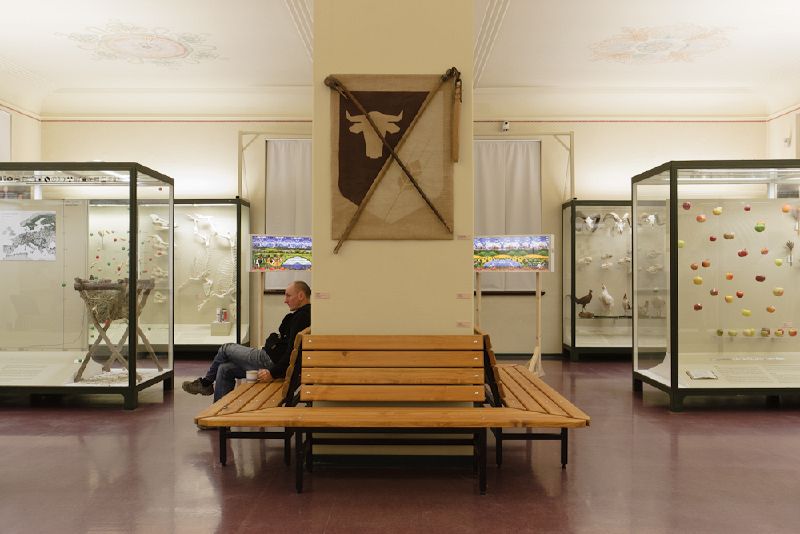 The Phyletisches Museum's "Medusensaal" special exhibition area showing the Domestikation exhibition. The exhibition logo and the bench around the central column were designed by Elisabeth Kaufmann & Felix Sattler and Konrad Angermüller (graphic design). Foto: Felix Sattler
The Phyletisches Museum's "Medusensaal" special exhibition area showing the Domestikation exhibition. The exhibition logo and the bench around the central column were designed by Elisabeth Kaufmann & Felix Sattler and Konrad Angermüller (graphic design). Foto: Felix Sattler
